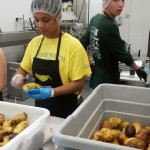On July 22, the Vermont Foodbank hosted a group from The Governor’s Institute of Vermont, which gleaned and processed food for distribution to Vermonters in need.
The Governor’s Institute students also worked at the Center for an Agricultural Economy’s shared use processing facility in Hardwick, processing vegetables into packaged and cut forms. All of the food was distributed by the Vermont Foodbank to food shelves and meal sites throughout Vermont, helping to make fresh food more accessible to Vermonters in need, especially the elderly and disabled who may have a harder time processing and cooking fresh food.
One student shared his experience with us:
My name is Gus Obeldobel and I’m a sophomore at U-32 High School. I play soccer and basketball and raise meat birds in the spring and summer to butcher and sell. My family also has 2 large gardens where we grow a variety of crops.
This past summer I attended the Governor’s Institutes of Vermont. I went to Farms, Food, and Your Future for a week and we visited many places and did many things. We visited the Vermont Foodbank Wolcott Distribution Center and Pete’s Greens in Craftsbury.
After learning about the Foodbank, we were split into two groups, put on our hair nets, and got to work. My group was the potato group while the other worked with the carrots. The first thing we did was get a barrel of potatoes from the big box outside of the kitchen. We then brought it inside the kitchen and were split into three smaller groups. The group that I was in washed the potatoes, while the next group cut out bruises and bad parts, and the last group ran the potatoes through a small machine that cut the potatoes into wedges to be packaged.
While we were doing this, the carrot group was in a kitchen next door. Their process was simple and wet. They started with a group cutting the ends off of the carrots so that there weren’t any sour parts. From there, the carrots were put into a machine with a rough interior that shook and de-skinned the carrots. This machine required a lot of water and the water drained right out of the bottom so we had to watch out. We then took the carrots out of there and put them into another machine that chopped them up and spit them out into a bucket. From there they were ready to be packaged.
We worked in these two kitchens all morning, switching jobs and trying different things. Eventually we had two groups that packaged the veggies and put them into the giant, walk-in freezer. While this work was hard and tiring, it felt good to be helping out the community.
We ended up doing roughly 600 lbs of veggies, which is way more than the staff could’ve done in that time if we weren’t there. It was really amazing at just how much food goes through that place. I could see when I was putting boxes in the freezer how many other boxes were already in there and ready to be shipped out and eaten.
After we were done in the kitchens and had cleaned up, we had lunch outside. Once we’d eaten, we talked about the process and what we thought. From there we went to Pete’s Greens which was just a few minutes down the road from the Foodbank’s Wolcott facility. At Pete’s, we gleaned with a few other people who work for the Foodbank.
It was really hot in the greenhouse, but we did a ton of work! We picked roughly 2,500 lbs of beets in just over an hour, which was more than could fit in the truck. I think this was the most rewarding part of our day because it was the hardest work and we could see all of the beets in a pile afterwards.
This whole experience was really great in general. I loved being able to help the community with all of my friends that I met and made that day. I hope that GIV and the Vermont Foodbank continue to do this in the future so that more kids can share this awesome experience.
Thank you, Gus, for sharing your experience. And thank you to The Governor’s Institute of Vermont for making this experience possible!


